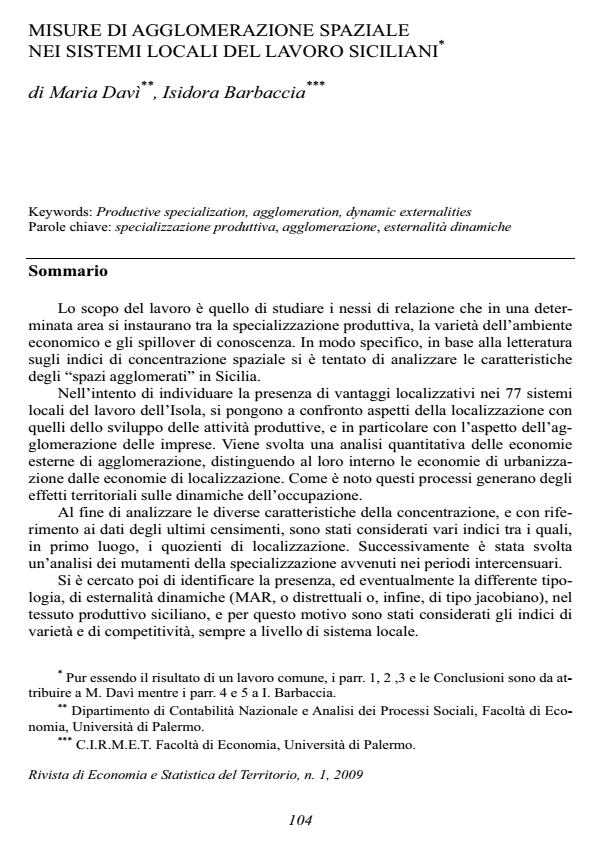Misure di agglomerazione spaziale nei Sistemi Locali del Lavoro siciliani
Journal title RIVISTA DI ECONOMIA E STATISTICA DEL TERRITORIO
Author/s Maria Davì, Isidora Barbaccia
Publishing Year 2009 Issue 2009/1
Language Italian Pages 33 P. 104-136 File size 312 KB
DOI 10.3280/REST2009-001005
DOI is like a bar code for intellectual property: to have more infomation
click here
Below, you can see the article first page
If you want to buy this article in PDF format, you can do it, following the instructions to buy download credits

FrancoAngeli is member of Publishers International Linking Association, Inc (PILA), a not-for-profit association which run the CrossRef service enabling links to and from online scholarly content.
Spatial agglomeration indicators in the Sicilian Local Labour Systems Objectives - This paper examines the links among productive specialization, variety of the economic environment and knowledge spillovers on the basis of the territorial analyses present in the current literature. With the aim of identifying localization benefits in a particular area, some aspects of business settling are compared with trends in the development of economic activities and, particularly, with agglomeration process of the firms. Methods and Results The empirical analysis will be carried out pointing to the dynamics of employment consequent to the effects of the externalities above mentioned. Employment data are taken from the Manufacturing and Service Censuses of the years 1981, 1991 and 2001 and refer to the 77 Sicilian Local Labour Systems. Precisely, data pertain to the following sections of the classification ATECO 2002: Mining and quarrying (C), Manufacturing (D) and Total private services (G, H, I, J, K). We consider some suitable economic indicators to depict the characteristics of concentration: _ localization ratios for studying the evolutionary trends in specialization for different types of economic activity; _ diversity measures, based on a Hirschman-Herfindahl index, suggesting the presence of Jacobs-type dynamic externalities or, on the contrary, the operativeness of MAR dynamic effects; _ competition indices to gather information about the competition levels of the markets depending on their structure; _ agglomeration indices, to measure the geographic concentration of the economic activity connected to high and/or increasing industrial concentration levels in the adjacent LLS. Conclusions The agglomeration process results from inter-sector links, easing the diffusion of innovations thanks to the variety of urban contexts. Agglomeration forces appear to be outweighed, especially since 2001, by the influence of co-agglomeration factors due to the presence, in the same local reality, of small-sized enterprises belonging to different sectors. Owing to the increasing interdependence among sectors, these effects caused a redistribution of employment among the different groups of economic activities. The indexes showed how, during the inter-census gaps, a despecialization trend took over, bringing local production structures constantly closer to the average regional values.
Maria Davì, Isidora Barbaccia, Misure di agglomerazione spaziale nei Sistemi Locali del Lavoro siciliani in "RIVISTA DI ECONOMIA E STATISTICA DEL TERRITORIO" 1/2009, pp 104-136, DOI: 10.3280/REST2009-001005